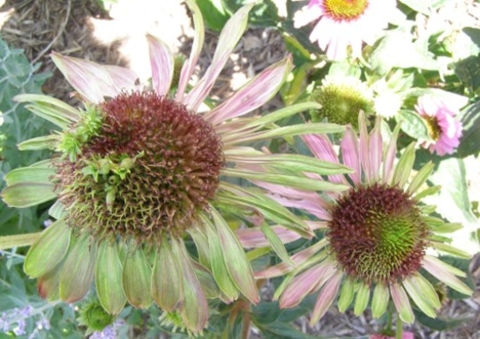Aster yellows is a fairly common disease that can cause strange symptoms in a wide variety of plants. It can infect over 300 kinds of plants in 48 families, including a wide variety of vegetables, ornamentals, field crops and weeds.
What causes aster yellows?
Aster yellows is caused by a tiny organism called a phytoplasma, similar to a bacterium. The phytoplasma is carried from plant to plant by leafhoppers. The leafhopper acquires the phytoplasma by feeding on the phloem cells of an infected plant. It then transmits the bacterium to another plant when it feeds again. Multiplication of the organism occurs within the leafhopper, so the insect can transmit the disease throughout its life—which is 100 days or longer.
Aster yellows is a common and destructive disease worldwide, although it is rare in areas where air temperatures are above 90°F (32°C) for extended periods. Typical symptoms of aster yellows include veins that turn pale, yellowing of new leaves, abnormally bushy growth, deformed flowers and stunting. Taproots, especially those of carrots, may develop excessively hairy roots. In other cases, leaves often form where flowers should be present and flower petals are frequently green. Symptoms are more pronounced in hot weather, and in cool weather, a plant can be infected without showing any symptoms.
How can I control it?
Aster yellows is difficult to control because of the number and diversity of plants attacked. Control of this disease is best accomplished by preventing the entrance of phytoplasma into your planted areas.
Remove diseased plants
Once a plant is infected with aster yellows, it is infected for life. There is no cure. Early diagnosis and prompt removal of infected plants may help reduce the spread of the disease. Although the disease itself is not fatal to the plant, its presence makes it impossible for a plant to fulfill its intended role in the garden.
Plant less susceptible plant species
As long as infected leafhoppers are around, they can infect plants. A practical way to avoid having problems with this disease is to grow plants that are not as susceptible to aster yellows. Verbena, salvia, nicotiana, geranium, cockscomb and impatiens are among the least susceptible plants.
Control weeds
Remove weeds in your lawn, garden and surrounding areas. Many weeds act as hosts for the microorganism.
Find more information on aster yellows disease.


